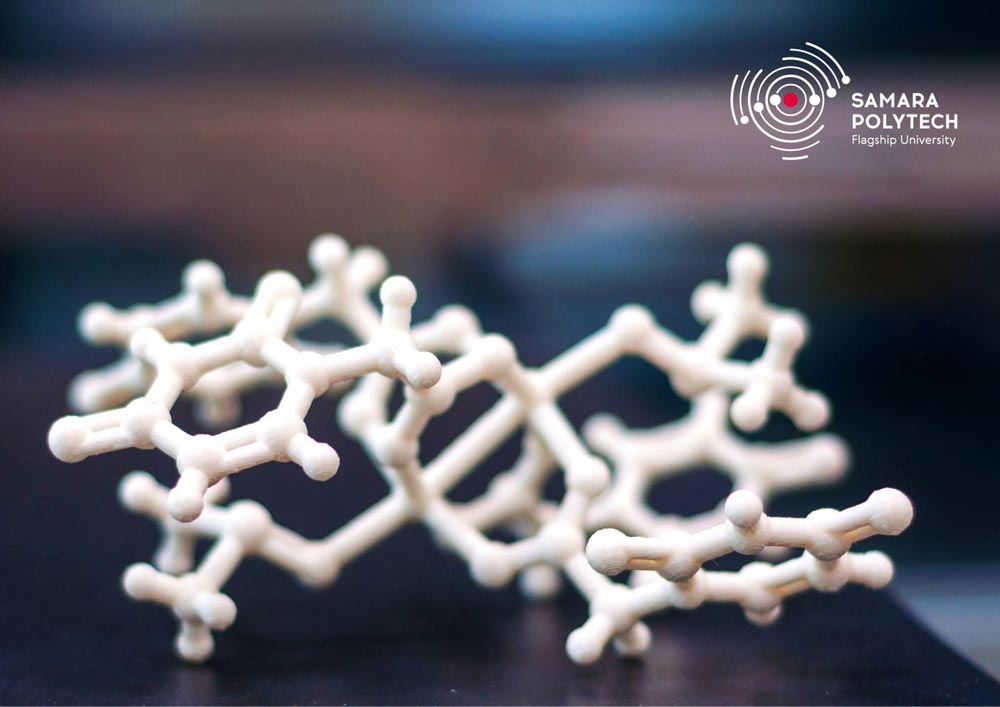
First Metal-Organic Coordination Polymers Synthesized at Samara Polytech

New materials resemble an assemblage from a construction kit within which individual molecules and their fragments can be combined in a framework.
Credit: @SamaraPolytech
Under the leadership of the head of the laboratory for the synthesis of new crystalline materials of the Samara Center for Theoretical Materials Science (SCTMS) of the Samara Polytech candidate of chemical sciences Eugeny Alexandrov and the head of the department “Chemistry and Technology of Chemical Compounds of Nitrogen”, doctor of technical sciences Andrei Pimenov, the synthesis of the first metal-organic polymeric materials, or metal-organic frameworks (MOFs).
Recent results of research were published in the scientific journals Dalton Transactions and Chemical Science of publisher The Royal Society of Chemistry, as well as Crystal Growth & Design of American Chemical Society.
The obtained porous metal-organic frameworks attract the attention of scientists by the fact that they demonstrate record sorption characteristics in relation to various volatile substances, gases, liquids and ions. This is a kind of crystalline sponge, but with unique parameters.
One gram of such a substance has a pore surface area comparable to the area of a football field. In addition, they are able to combine several useful properties: magnetic susceptibility, luminescence, electrical conductivity, catalytic activity, and much more. This allows you to create advanced materials for sensors and detectors on their basis, for storing and processing information, photocells, nanoreactors.
«We have a real chance to develop in Samara the technologies for the manufacture of new materials for energy-efficient sorption separation of oil products and industrial gases, as well as for highly selective and highly sensitive chemical sensors, – says the candidate of chemical sciences, head of the laboratory of the center Eugeny Alexandrov. – Development of various aspects (sorption, electrical conductivity, mechanical stability, structure design) of this topic has already been supported by the research grants of the RSF, RFBR and the presidential grant. In addition, applications were sent to two scientific foundations and an industrial partner is being sought.
More than 20 crystal samples of both known and new, not yet studied, porous and electrically conductive metal-organic coordination polymers have been synthesized by the candidate of chemical sciences Andrei Sokolov, Viktor Parfenov, and student Ekaterina Vaganova in the laboratory of the University.
These are materials with high porosity, good stability and sorption ability of the components of natural gas, air, gaseous and liquid industrial emissions. Together with the staff of the Department of Physical Chemistry and Chromatography of Samara University (the head of the department, Professor Lyudmila Onuchak), it is planned to manufacture composite materials on their basis and study the surface topography of these composites, their ability to hold various substances on the surface – for example, components of natural gas.
Together with the head of the Scientific and Educational Center of Medical Diagnostic Microsystems at the Institute for Innovative Development of Samara State Medical University Andrei Sokolov, it is planned to create chemical sensors and cathode materials for metal-ion batteries based on MOFs.
«I consider these first syntheses of MOFs as a benchmark event in the development of our research center, – said Vladislav Blatov, Professor, Director of SCTMS. – Our center is very young: we are officially approved as a university unit at the very end of 2017. At the same time, in such a short period of time, with the support of the Polytech, we were able to do what we had long dreamed of – to begin the practical implementation of our theoretical forecasts of new crystalline substances and materials in our laboratory».
###
The research of scientists of the Samara Polytechnic University is supported by the grant from the Russian Science Foundation (RSF).
For reference:
The Samara Center for Theoretical Materials Science (SCTMS) was established in 2017 as a unit of the Samara Polytech. The scientists of the center are engaged in the development of new software for modeling new materials and the intellectual analysis of experimental data; the creation of a new generation of electronic databases for heuristic prediction of the physical properties of solids; development of an expert system for the effective search for materials with desired properties; organization of a computer center for calculating properties of solids by quantum-mechanical methods; the creation and support of an Internet portal on theoretical materials science; supporting an online forum on the use of theoretical methods in materials science; organization of schools, workshops, seminars on theoretical materials science.
Samara Polytech is a Flagship university, a powerful research and educational center and a leader in the preparation of elite engineering personnel. Scientists guide research and development in almost all strategic sectors: Petrochemistry, Oil and Gas Production and Processing, Energy, Information, Pharmaceutical and Food Technologies, Construction and Architecture. In addition, the university actively participates in the State Armament Program, in solving strategic problems of the region and implementing significant projects of federal significance. University graduates are famous Russian scientists, government officials, leaders of leading companies.









![[1] Key Research Findings on Transfer-Printed Alumina–Gold Dual-layer Protective Coating](https://www.innovations-report.com/wp-content/uploads/2025/07/Transfer_printing_technology_for_lithium_protectiv_1753252750-e1753252940671-362x245.jpg)


